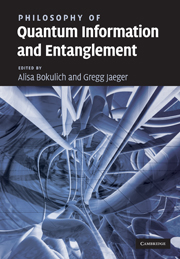Book contents
- Frontmatter
- Contents
- List of contributors
- Preface
- Introduction
- Part I Quantum entanglement and non-locality
- Part II Quantum probability
- 4 Bell's inequality from the contextual probabilistic viewpoint
- 5 Probabilistic theories: What is special about Quantum Mechanics?
- 6 What probabilities tell about quantum systems, with application to entropy and entanglement
- 7 Bayesian updating and information gain in quantum measurements
- Part III Quantum information
- Part IV Quantum communication and computing
- Index
6 - What probabilities tell about quantum systems, with application to entropy and entanglement
from Part II - Quantum probability
Published online by Cambridge University Press: 04 August 2010
- Frontmatter
- Contents
- List of contributors
- Preface
- Introduction
- Part I Quantum entanglement and non-locality
- Part II Quantum probability
- 4 Bell's inequality from the contextual probabilistic viewpoint
- 5 Probabilistic theories: What is special about Quantum Mechanics?
- 6 What probabilities tell about quantum systems, with application to entropy and entanglement
- 7 Bayesian updating and information gain in quantum measurements
- Part III Quantum information
- Part IV Quantum communication and computing
- Index
Summary
Introduction
The use of parameters to describe an experimenter's control over the devices used in an experiment is familiar in quantum physics, for example in connection with Bell inequalities. Parameters are also interesting in a different but related context, as we noticed when we proved a formal separation in quantum mechanics between linear operators and the probabilities that these operators generate. In comparing an experiment against its description by a density operator and detection operators, one compares tallies of experimental outcomes against the probabilities generated by the operators but not directly against the operators. Recognizing that the accessibility of operators to experimental tests is only indirect, via probabilities, motivates us to ask what probabilities tell us about operators, or, put more precisely, “what combinations of a parameterized density operator and parameterized detection operators generate any given set of parametrized probabilities?”
Here, we review and augment recent proofs that any given parameterized probabilities can be generated in very diverse ways, so that a parameterized probability measure, detached from any of the (infinitely many) parameterized operators that generate it, becomes an interesting object in its own right. By detaching a parameterized probability measure from the operators that may have led us to it, we (1) strengthen Holevo's bound on a quantum communication channel and (2) clarify a role for multiple levels of modeling in an example based on quantum key distribution. We then inquire into some parameterized probability measures generated by entangled states and into the topology of the associated parameter spaces; in particular we display some previously overlooked topological features of level sets of these probability measures.
- Type
- Chapter
- Information
- Philosophy of Quantum Information and Entanglement , pp. 127 - 150Publisher: Cambridge University PressPrint publication year: 2010

